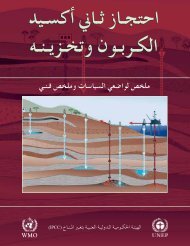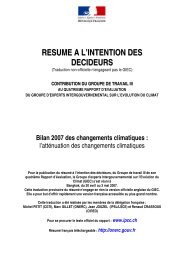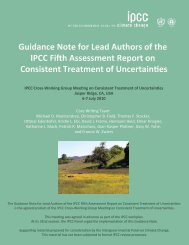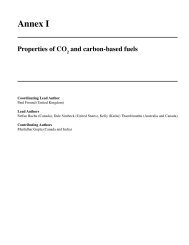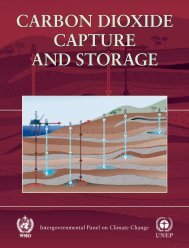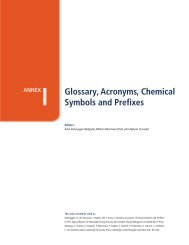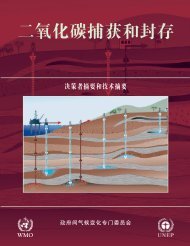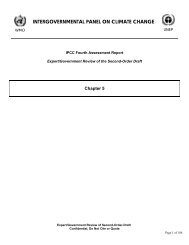SODBatch A&B SPM Comments co-chair response final ... - ipcc-wg3
SODBatch A&B SPM Comments co-chair response final ... - ipcc-wg3
SODBatch A&B SPM Comments co-chair response final ... - ipcc-wg3
You also want an ePaper? Increase the reach of your titles
YUMPU automatically turns print PDFs into web optimized ePapers that Google loves.
Chapter-<br />
Comment<br />
para<br />
426 T<br />
1<br />
<strong>SPM</strong>-<br />
427<br />
<strong>SPM</strong>-<br />
428<br />
<strong>SPM</strong>-<br />
429<br />
<strong>SPM</strong>-<br />
430<br />
<strong>SPM</strong>-<br />
431<br />
<strong>SPM</strong>-<br />
432<br />
5<br />
T<br />
1<br />
5<br />
T<br />
1<br />
5<br />
T<br />
1<br />
5<br />
T<br />
1<br />
5<br />
T<br />
1<br />
5<br />
T<br />
1<br />
Batch<br />
From Page<br />
From Line<br />
To Page<br />
To line<br />
<strong>Comments</strong><br />
IPCC WGIII Fourth Assessment Report, Se<strong>co</strong>nd Order Draft<br />
chart e.g., global mean temperature increase above pre-industrial<br />
vs. multigas <strong>co</strong>ncentration stabilisation level. The two <strong>co</strong>lumns,<br />
probability of staying below 2 (and 3) degrees C above preindustrial<br />
at equilibrium, do not provide any additional value and<br />
are very <strong>co</strong>nfusing. Related footnotes (2,3,4,5, and 7) are too short<br />
for professionals and are too <strong>co</strong>mplicated for policy makers. It may<br />
be useful to discuss what is the <strong>co</strong>rrect temperature for the planet.<br />
(Government of Environment Canada)<br />
A 6 0 6 0 Table <strong>SPM</strong>1. For Class E, "Peaking level for CO2 emissions", the<br />
end year of 2090 seems out of place (ie should be later) <strong>co</strong>mpared<br />
with the end year for the other classes.<br />
(Government of Environment Canada)<br />
A 6 0 0 0 table <strong>SPM</strong>.1, suggest to invert rows 2-6 and change classes to be<br />
<strong>co</strong>herent with the proposed changes in figure <strong>SPM</strong>.5<br />
(Government of The Netherlands)<br />
A 6 0 0 0 table <strong>SPM</strong>.1, <strong>co</strong>lumns 2 and 3, rows 2 and 6: it is unclear why the<br />
top respectively bottom radiative forcings are given for a<br />
stabilisation range, where a radiative forcing range is given for the<br />
other stabilisation ranges in rows 3-5; this seems to be in<strong>co</strong>nsistent<br />
with table TS.4<br />
(Government of The Netherlands)<br />
A 6 0 0 0 table <strong>SPM</strong>.1, <strong>co</strong>lumn 8, rows 6: shouldn't this read "exeptionally<br />
unlikely"; <strong>co</strong>llumn 10, rows 5 and 6: it seems not logic that peaking<br />
for 930 ppme would need to occur before 2090, while peaking for<br />
785 ppme <strong>co</strong>uld be postponed untill 2100<br />
(Government of The Netherlands)<br />
A 6 0 6 0 Table <strong>SPM</strong> 1, <strong>co</strong>lumn 9. The descriptions are unclear, please<br />
clarify. E.g. what is the meaning of "Likely to as likely as not", or<br />
of "About as likely as not to unlikely".<br />
(Government of Finland)<br />
A 6 0 0 0 Table <strong>SPM</strong> 1: It should be made clear here and throughout the <strong>SPM</strong><br />
whether the multigas stabilisation scenarios as well as the<br />
anthropogenic addition to radiative forcing include only long lived /<br />
well mixed GHG (as <strong>co</strong>vered by the Kyoto Proto<strong>co</strong>l) or if short<br />
Expert Review of Se<strong>co</strong>nd-Order-Draft<br />
Confidential, Do Not Cite or Quote<br />
Response suggested by <strong>co</strong><strong>chair</strong>s<br />
ACC expanding footnotes<br />
DISCUSS; this should reflect<br />
the literature assessed<br />
UNCLEAR<br />
DISCUSS; W/m2 <strong>co</strong>lumn to be<br />
dropped (to simplify); ranges<br />
should reflect literature (see also<br />
A-427)<br />
See A-418<br />
DISCUSS; this is caused by the<br />
literature; chapter 3 to <strong>co</strong>nsider<br />
if more selective use of studies<br />
is justified to get a more<br />
meaningful result<br />
REJ; this is standard IPCC<br />
terminology; uncertainty annes<br />
to be added<br />
ACC<br />
Action<br />
for<br />
chapter<br />
Considerations<br />
by the writing<br />
team<br />
3 Noted. See<br />
<strong>co</strong>mment <strong>SPM</strong>-<br />
421.<br />
(3)<br />
3 Noted. See<br />
<strong>co</strong>mment <strong>SPM</strong>-<br />
421.<br />
(3)<br />
Page 106 of 348



